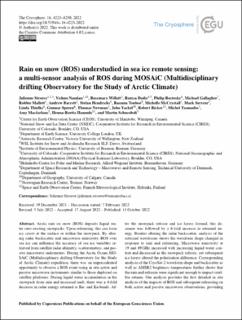| dc.contributor.author | Stroeve, Julienne | |
| dc.contributor.author | Nandan, Vishnu | |
| dc.contributor.author | Willatt, Rosemary | |
| dc.contributor.author | Dadic, Ruzica | |
| dc.contributor.author | Rostosky, Philip | |
| dc.contributor.author | Gallagher, Michael | |
| dc.contributor.author | Mallett, Robbie | |
| dc.contributor.author | Barrett, Andrew | |
| dc.contributor.author | Hendricks, Stefan | |
| dc.contributor.author | Tonboe, Rasmus | |
| dc.contributor.author | McCrystall, Michelle | |
| dc.contributor.author | Serreze, Mark | |
| dc.contributor.author | Thielke, Linda | |
| dc.contributor.author | Spreen, Gunnar | |
| dc.contributor.author | Newman, Thomas | |
| dc.contributor.author | Yackel, John | |
| dc.contributor.author | Ricker, Robert | |
| dc.contributor.author | Tsamados, Michel | |
| dc.contributor.author | Macfarlane, Amy | |
| dc.contributor.author | Hannula, Henna-Reetta | |
| dc.contributor.author | Schneebeli, Martin | |
| dc.date.accessioned | 2023-09-15T08:55:34Z | |
| dc.date.available | 2023-09-15T08:55:34Z | |
| dc.date.created | 2022-11-17T15:33:31Z | |
| dc.date.issued | 2022 | |
| dc.identifier.citation | The Cryosphere. 2022, 16 (10), 4223-4250. | en_US |
| dc.identifier.issn | 1994-0416 | |
| dc.identifier.uri | https://hdl.handle.net/11250/3089671 | |
| dc.description.abstract | Arctic rain on snow (ROS) deposits liquid water onto existing snowpacks. Upon refreezing, this can form icy crusts at the surface or within the snowpack. By altering radar backscatter and microwave emissivity, ROS over sea ice can influence the accuracy of sea ice variables retrieved from satellite radar altimetry, scatterometers, and passive microwave radiometers. During the Arctic Ocean MOSAiC (Multidisciplinary drifting Observatory for the Study of Arctic Climate) expedition, there was an unprecedented opportunity to observe a ROS event using in situ active and passive microwave instruments similar to those deployed on satellite platforms. During liquid water accumulation in the snowpack from rain and increased melt, there was a 4-fold decrease in radar energy returned at Ku- and Ka-bands. After the snowpack refroze and ice layers formed, this decrease was followed by a 6-fold increase in returned energy. Besides altering the radar backscatter, analysis of the returned waveforms shows the waveform shape changed in response to rain and refreezing. Microwave emissivity at 19 and 89 GHz increased with increasing liquid water content and decreased as the snowpack refroze, yet subsequent ice layers altered the polarization difference. Corresponding analysis of the CryoSat-2 waveform shape and backscatter as well as AMSR2 brightness temperatures further shows that the rain and refreeze were significant enough to impact satellite returns. Our analysis provides the first detailed in situ analysis of the impacts of ROS and subsequent refreezing on both active and passive microwave observations, providing important baseline knowledge for detecting ROS over sea ice and assessing their impacts on satellite-derived sea ice variables. | en_US |
| dc.language.iso | eng | en_US |
| dc.relation.uri | https://tc.copernicus.org/articles/16/4223/2022/#section16 | |
| dc.rights | Navngivelse 4.0 Internasjonal | * |
| dc.rights.uri | http://creativecommons.org/licenses/by/4.0/deed.no | * |
| dc.title | Rain on snow (ROS) understudied in sea ice remote sensing: a multi-sensor analysis of ROS during MOSAiC (Multidisciplinary drifting Observatory for the Study of Arctic Climate) | en_US |
| dc.title.alternative | Rain on snow (ROS) understudied in sea ice remote sensing: a multi-sensor analysis of ROS during MOSAiC (Multidisciplinary drifting Observatory for the Study of Arctic Climate) | en_US |
| dc.type | Peer reviewed | en_US |
| dc.type | Journal article | en_US |
| dc.rights.holder | © Author(s) 2022 | en_US |
| dc.description.version | publishedVersion | en_US |
| cristin.ispublished | true | |
| cristin.fulltext | original | |
| cristin.qualitycode | 2 | |
| dc.identifier.doi | 10.5194/tc-16-4223-2022 | |
| dc.identifier.cristin | 2075794 | |
| dc.source.journal | The Cryosphere | en_US |
| dc.source.volume | 16 | en_US |
| dc.source.issue | 10 | en_US |
| dc.source.pagenumber | 4223-4250 | en_US |
| dc.relation.project | EC/H2020/ARICE 730965) | en_US |
| dc.relation.project | Andre: Canada Excellence Research Chairs grant no. G00321321 | en_US |
| dc.relation.project | ESA - den europeiske romfartsorganisasjonen: 5001027396 | en_US |
| dc.relation.project | Andre: US Dept of Energy (DOE) - DE-SC0019251 and DE-SC0021341 | en_US |
| dc.relation.project | Deutsche Forschungsgemeinschaft: 221211316 | en_US |
| dc.relation.project | Andre: Bundesministerium für Bildung und Forschung - 03F0866B | en_US |
| dc.relation.project | Norges forskningsråd: ICER 1928230 | en_US |
| dc.relation.project | Andre: Swiss Polar Institute - grant no. EXF-2018-003 | en_US |
| dc.relation.project | Natural Environment Research Council: NE/S002510/1 and NE/L002485/1 | en_US |

